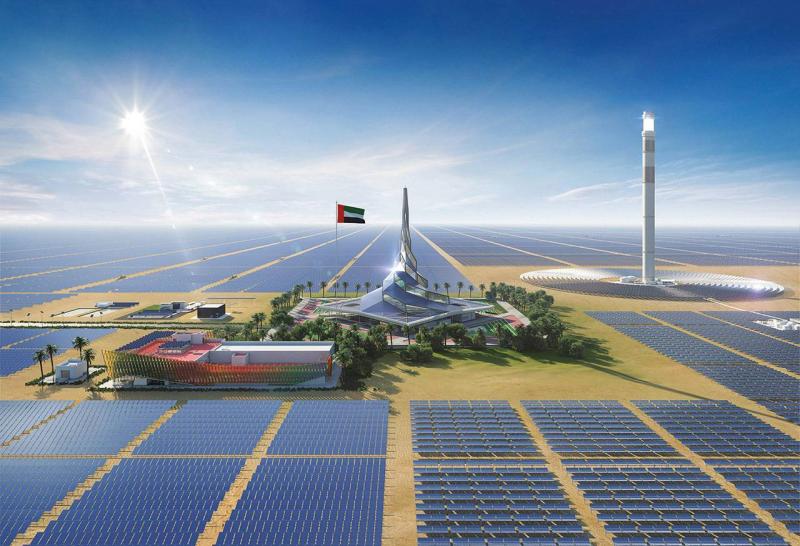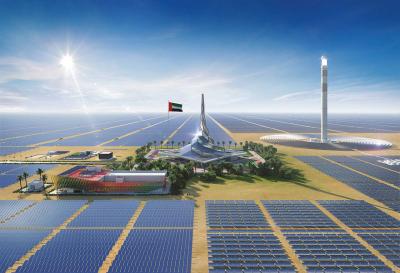Officials and experts have confirmed that the main focus of the United Arab Emirates (UAE) in the coming period will be the expansion of clean energy projects, increasing reliance on Fourth Industrial Revolution technologies and digitization, enhancing globally leading levels of infrastructure with the highest standards of reliability, efficiency, and availability, and achieving pioneering results in reducing carbon emissions. The wise leadership places significant importance on promoting sustainable development and securing energy supplies to fulfill the UAE's vision of becoming the best country in the world by 2071. Renewable energy emerges as a foundational pillar of sustainability and the core of the next 50 years, positioning it as a top strategic priority for the UAE, which leads pioneering efforts to adopt the latest innovations driving the response to climate change and mitigating global warming, contributing significantly to the support of the "United Nations Sustainable Development Goals 2030."
Initially, His Excellency Saeed Mohammed Al Tayer, Managing Director and CEO of Dubai Electricity and Water Authority (DEWA), stated that the UAE has taken early steps towards preparing to bid farewell to the last drop of oil, achieving a balance between development and maintaining a clean, healthy, and safe environment. Today, the UAE leads global efforts in the clean and renewable energy sector through its strategies and investments in this field. The UAE Energy Strategy 2050 aims for a mix of renewable and clean energy sources to ensure a balance between economic needs and environmental goals. The state plans to invest 600 billion dirhams by 2050 to meet energy demand and ensure sustainable growth in the country's economy. He continued, "DEWA is committed to innovating proactive solutions for the challenges of the next fifty years, enhancing efforts to make the UAE the most innovative and future-ready nation." Given that the clean and renewable energy sector will lead the innovation process in the future, DEWA aims to achieve Dubai's Clean Energy Strategy 2050, launched by His Highness Sheikh Mohammed bin Rashid Al Maktoum, Vice President and Prime Minister of the UAE, which aims to provide 75% of Dubai's energy production capacity from clean energy sources by 2050.
He added that DEWA has launched major projects in renewable and clean energy, notably the Mohammed bin Rashid Al Maktoum Solar Park, which is the largest strategic renewable energy project in one location in the world, following the Independent Power Producer (IPP) model, as well as the Hassyan Clean Coal Power Plant, and the first-of-its-kind hydroelectric station in the Gulf region aimed at generating electricity using stored water from the Hatta dam. The "Green Hydrogen" project, the first of its kind in the Middle East and North Africa, is being implemented in collaboration between DEWA, Expo 2020 Dubai, and Siemens Germany. In addition to our major projects, we aim to engage Dubai residents in the process of producing clean energy through the "Shams Dubai" initiative. DEWA also has investments exceeding 86 billion dirhams over five years to meet the growing demand for electricity and water in the emirate, working through its diverse project portfolio to transform Dubai into a global hub for clean energy, integrating various disruptive technologies while focusing on diversifying the energy mix.
For his part, Mohamed Saleh, General Manager of the Federal Electricity and Water Authority, emphasized that most international and global reports related to this field recommend that renewable energy sources play a larger role in global energy supplies, to confront the environmental and economic threats posed by climate change. He pointed out the importance of strengthening cooperation and partnership between the public and private sectors at various levels through effective and harmonious coordination to translate the UAE Energy Strategy 2050, noting that our wise leadership formulated the strategy based on thorough and careful study of the geographic, climatic, economic, and social conditions of the country and region to achieve energy security. He underscored the importance of the national energy strategy, which includes providing a harmonious and balanced mix of clean, nuclear, and fossil energy sources, ensuring the necessary balance between economic and environmental goals. Regarding water, it is known that the UAE is one of the countries lacking permanent fresh water sources due to its geographic location and desert climate. It primarily relies on seawater desalination, which led the wise government to adopt the national water security strategy aimed at ensuring and maintaining access to water under all circumstances, adhering to the highest global standards in the field.
Efforts continue, as Saif Hamid Al-Falasi, CEO of ENOC Group, affirmed that the UAE has developed the UAE Energy Strategy 2050, outlining the future of a low-carbon energy mix, consisting of 38% gas, 44% clean energy, 6% nuclear energy, and 12% clean coal. The government is exerting significant efforts to enhance low-carbon renewable energy growth, and substantial changes are already being witnessed in this area. He continued, "The UAE government intends to invest 600 billion dirhams by 2050 to meet the growing energy demand and ensure sustainable growth for the economy, while the strategies to mitigate the adverse effects of climate change and build a green economy are fundamental themes for sustainability at Expo 2020 Dubai." The Barakah nuclear power plant in the UAE is another example of the UAE's leadership in achieving a low-carbon future. Al-Falasi emphasized the need for a strong commitment from companies directly contributing to driving research in sustainable energy, which requires backing from governmental legislation, as everyone is responsible for providing a better future for upcoming generations, and it is our duty to lay the foundation for the next decades.
In addition, Hamad Al-Tuniji, Director of the Energy Transmission Department at the Sharjah Electricity, Water, and Gas Authority, stated that there must be a necessary balance between sustainable development and environmental preservation by adopting renewable energy technologies such as solar, wind, and hydroelectric power from dams, among others, since they are renewable energy sources that do not diminish with consumption as they are replenished. They are also clean energy that does not pollute the air or change the climate and are available everywhere. These technologies have reached a level of technical maturity, efficiency, and economic feasibility that makes them the best option to ensure energy sources for future generations over the next fifty years and beyond. He added, "The trend towards renewable energy technologies and their broad application has increased, with solar photovoltaic energy being the most accepted and cost-effective option.” During the past decade, solutions have been developed to address the challenges of expanding the application of solar energy technologies.
Al-Tuniji explained that the targeted energy mix in the UAE Energy Strategy 2050 includes reaching a rate of 44% from clean energy sources. He pointed out that to combat the challenges in securing energy and water, it is essential to build a culture of rationalizing electricity and water consumption for resource sustainability, gradually increasing the contribution of renewable energy sources to the energy mix, and expanding energy storage solutions, as well as using renewable energy for seawater desalination and storing surplus. He noted that there is a challenge facing renewable energy characterized by its intermittent availability during daylight hours, and that energy storage technologies still need time to reach a level of reliability and acceptable cost. Here, the role of natural gas as a reliable and low-carbon footprint support for energy supply emerges during interruptions in renewable energy sources.




